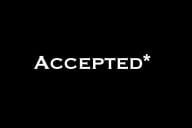You have /5 articles left.
Sign up for a free account or log in.
Recently, I dedicated two weekends to that time-honored graduate-student rite of passage, the academic conference. In those intervals between the battery of panel sessions spent wandering hotel corridors with dog-eared program in hand, as well as during the last long bus ride back home, I had time to reflect on my colleagues’ performances as well as my own. Simply put, I noticed that there are some practices that contribute toward engaging presentations, and other habits that make for canned, lifeless recitation.
Graduate students especially, I observed, seem to gravitate toward one of two unfortunate oratory personas. One archetype is the perhaps well-prepared but painfully meek presenter who races through her text without pausing to take a breath. Hunched over the lectern, terrified and yet robotic, like a contestant on a game show with no reward but to avoid public humiliation. The other type is the scholar who doesn’t regard the limits -- neither of chronological time nor of the attention span of the audience. Shuffling pages of marked-up drafts, it’s all excess, aggregated thoughts without conclusion. A verbal Pollock painting, some method but mostly mess.
I witnessed variations on both kinds of presentation and, content aside, each is symptomatic of the same underlying features of post-graduate life: one is often at a low point in intellectual confidence, one has yet to produce original work, and most importantly, one is new at this. So one either communicates this felt fragility or compensates for it with unmeasured bombast.
While I am trained in geography and anthropology, I believe much of what I share here could be useful to budding humanists and natural scientists, too. From my limited but fresh experiences in academic conferences, I’d like to take you through the process, from selecting events to participate in to the live performance itself. In the spirit of efficiency celebrated by conference presentations themselves, I will organize these ideas in outlined bulleted form.
Find a suitable conference
- Sign up for e-mail listservs for subfields and organizations you are interested in. Throughout the year you will get call-for-paper announcements offering panel discussions to be a part of. Pay attention to the deadline and guidelines. Read their panel description closely. Often they will have a certain rubric within which they are working, with a theoretical approach either tacitly or explicitly signaled.
- There are many regional and graduate-student conferences organized for people still early in their careers. If you are at the dissertation proposal stage or still formulating your project, these kinds of events are a good idea. A grad student conference I attended in Boulder, Colorado, included very helpful workshop sessions on writing and theoretical approaches to the conference theme (“states of belonging”).
- Many conferences also accept individual papers. You submit your abstract and they will place you with other “orphan” presenters. You run a greater risk of not getting your paper accepted or getting stuck in a hodgepodge potpourri panel (like I was recently) if you opt for this approach.
Write a strong abstract
- Most conferences want you to participate (and want your conference fees payment), but they do have limits and criteria for accepting papers. A compelling abstract is critical. Often this is an awkward exercise because you have not written the paper for which you must make a synopsis. But the abstract can also be an opportunity to explore a theme or rubric you have not previously explored in your work.
- You usually have 200-300 words to work with (the conference I attended last weekend confined me to only 100!), so you don’t have space to elaborate sophisticated concepts, nor to tell everything about your project. Use keywords that signal a certain literature that, after examining the call for papers description, you know the organizers will be attuned to.
- Allude to a piece of research you have conducted or a field site/event/documentary source that will serve as the material your paper examines.
- HAVE A POINT your paper will advance. Even if you don’t yet know what that point is, make a concise and intelligible claim. Emphasize the innovative. The abstract doesn’t have to break new ground; it need only suggest your paper might do so.
Write the paper
- The organizers will often want you to submit the paper for a discussant to read before the conference and prepare comments. Unless the discussant otherwise allows it, do NOT send a whole dissertation chapter draft or anything exceeding 20 pages. At worst, the discussant will bear some contempt for this burden; at best, you are diluting her ability to give you concise feedback on your work. A presentation is typically limited to 15 minutes. It takes roughly 2 minutes to read a double-spaced page of text. So anything more than 7 or 8 pages is more than you can say in the presentation.
- Signal early on what your intentions with the paper are. Map out the argument so your audience can get a sense of what is to come.
- Write a data-driven essay. If you are an anthropologist, load it up with ethnographic material. If you are a historian or literature scholar, delve into the primary texts. This will give your discussant a better chance at assessing your analytical points. If you mire your argument in theoretical gobbledegook that you don’t command especially well, it will be frustrating for listeners. (There are moments when strategic obfuscation is advisable, of course.)
- Most importantly, you only have time in a presentation to develop ONE maybe two points. In any case, no one will remember more than two points, so keep it tight. It is always more effective to go in depth into one particular aspect of your research than try to sketch together myriad pieces in one whirlwind showcase.
Prepare the presentation
- The text you submitted to the discussant and what you have to say in the presentation will often not be the same. There are different opinions on this, but I believe priority #1 is to keep people’s attention for the time you are talking. People generally stay more tuned in when they sense that someone is speaking to them, not reading to them. Some reduce their presentation to a series of points they talk through. This has the advantage of being "live," but it also runs the risk of rambling. You might run out of time without a prepared text. One of my panel co-presenters last weekend ran well past his 15 minutes without ever coming to anything resembling a conclusion; he had to be unceremoniously cut off at 20 minutes with a curt "thank you" from the timekeeper. Ouch. Remember that by going overtime you are antagonizing your audience and colleagues on the panel. Be courteous.
- If you are going to read your paper, go to the trouble of making it "sound" better to listeners’ ears. Good general rule: Edit your text so that almost every sentence does not exceed one line in length. Cut down compound and complex sentences into simple declarative ones.
- Remove all but the most essential references in the spoken version.
- Practice reading your paper aloud for flow, emphasis, and timing. Replace unnecessary jargon or technical terms with more colloquial speech. You want to be familiar enough with the writing that you can pick your head up and speak to people.
- Rules of PowerPoint (PPT): Your PPT slides should absolutely NOT replace your paper; i.e., you should not simply read bullet points and text excerpts off the screen to your audience. Yawn.
- Your PPT show should complement your discourse. Show an image to illustrate a point you are making. Consider inserting a blank slide for portions of the presentation when you want the audience’s attention on you, not on the screen.
At the event
- If you are using audio-visual equipment, get to the room of your panel session early to test out the projector, software compatibility, etc.
- Listen to your co-presenters’ talks and take notes. Show the same undivided attention and respect you would expect from others when you speak.
- Graciously thank the organizers and/or sponsors before you set off into your paper.
- A basic tenet of all public speaking: whether you are reading or not, look up from your paper regularly to make eye contact with the audience. They will be more drawn to your words if they sense you acknowledge their presence and attention.
- Toward the end of your presentation, a timekeeper will usually hold up signs signaling your remaining time. Just acknowledge these with a nod and adjust your speech as needed. No need to interrupt your own talk with an exasperated, “Whoa! Only two minutes left?”
- If there is Q&A or discussion time, if the discussant or an audience member says something misinformed about your research, keep a poker face or give a polite acknowledging nod. If a question or comment inquires about further details of your work, still try to connect your reply to broader concerns. If time is running short, invite further one-on-one discussion after the session, e.g., "It’s interesting that you ask about X because it relates to Y, and I would love to hear more about it afterward."
I hope these reflections contribute toward making academic conferences a more rewarding experience for first-time presenters. These are key venues in the professionalization process, but it doesn’t have to entail an exercise in conformity. At the same time, these are formalized rituals with norms and conventions, and these guidelines are meant to encourage one to envision ways to express inventiveness and brio within the bounds of those tacit rules.








